
Imperial Bells
The imperial bells, also called bianzhong, is an ancient Chinese musical instrument consisting of a set of bronze bells, played melodically. These sets of chime bells were used as polyphonic musical instruments and some of these bells have been dated at between 2000 to 3600 years old. They were hung in a wooden frame and struck with a mallet. Along with the stone chimes called bianqing, they were an important instrument in China's ritual and court music going back to ancient times.
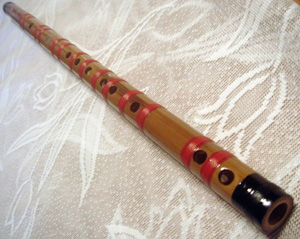
Chinese Bamboo Flute
Chinese bamboo flute is a Chinese transverse flute. It has varieties including the qudi and bangdi. The Chinese bamboo flute is a major Chinese musical instrument, and is widely used in many genres of Chinese folk music, as well as Chinese opera, and the modern Chinese orchestra. Traditionally, the dizi has also been popular among the Chinese common people, and it is simple to make and easy to carry.

Suona
The suona, also called laba or haidi, is a Han Chinese shawm (oboe). It has a distinctively loud and high-pitched sound, and is used frequently in Chinese traditional music ensembles, particularly those that perform outdoors. It is an important instrument in the folk music of northern China and has long been used for festival and military purposes.

Yangqin
The trapezoidal yangqin is a Chinese hammered dulcimer, originally from Central Asia (Persia). The yangqin is used both as a solo instrument and in ensembles.In the orchestra, the yangqin often adds to the harmony by playing chords or arpeggios. As the yangqin is softer than other Chinese instruments, it is usually positioned at the front of the orchestra, in the row just in front of the conductor. The yangqin has been called the "Chinese piano" as it has an indispensable role in the accompaniment of Chinese string and wind instruments.
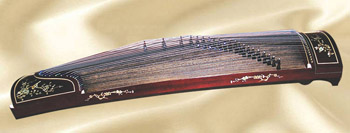
Guzheng
The guzheng is a Chinese plucked zither.The guzheng has existed since the Warring States Period and became especially popular during the Qin dynasty. The number of strings on the guzheng has always fluctuated, as we have as few as 6 to as many as 23 strings during the Tang dynasty. Until 1961, the common guzheng had 16 strings, although by the mid-20th century 18-string guzhengs were also in use.The guzheng is tuned to a pentatonic scale, the 16-string zheng is tuned to give three complete octaves, while the 21-string zheng has four complete octaves.
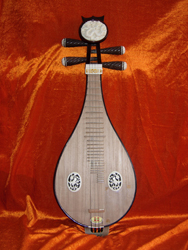
Liuqin
The liuqin is a four-stringed Chinese mandolin with a pear-shaped body. It has its own special place in Chinese music, whether in orchestral music or in solo pieces. A modernization in its usage in recent years leads to a gradual elevation in status of the liuqin from an accompaniment instrument in folk Chinese opera, narrative music to an instrument well-appreciated for its unique tonal and acoustic qualities.
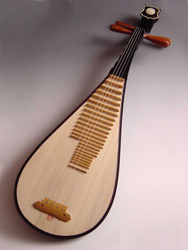
Pipa
The pipa is a four-stringed Chinese musical instrument. Sometimes called the Chinese lute, the instrument has a pear-shaped wooden body with a varying number of frets ranging from 12–26. The name "pipa" indicates the two most common ways of playing this instrument. "Pi" is to push the fingers of the right hand from right to left, and "pa" is to pull the thumb of the right hand from left to right.
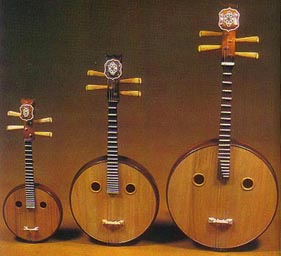
Ruan
The ruan is a Chinese plucked string instrument. It is a lute with a fretted neck, a circular body, and four strings. The modern ruan has 24 frets with 12 semitones on each string, which has greatly expanded its range from a previous 13 frets.
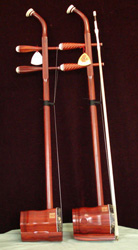
Erhu
The erhu, also called nanhu, and sometimes known in the West as the "Chinese violin" or "Chinese two-string fiddle," is a two-stringed bowed musical instrument, used as a solo instrument as well as in small ensembles and large orchestras. It is the most popular instrument in the huqin family of Chinese bowed string instruments. Used in both traditional and contemporary pieces, it is a versatile instrument.

Paigu
The Chinese paigu is a set of three to seven tuned drums (in most instances five are used), traditionally made of wood with animal skin heads. It is played by beating the heads (and sometimes also the body) with sticks. Most drums are double-sided and turnable. Both sides have different tunings. Tuning is done through the use of Allen keys.